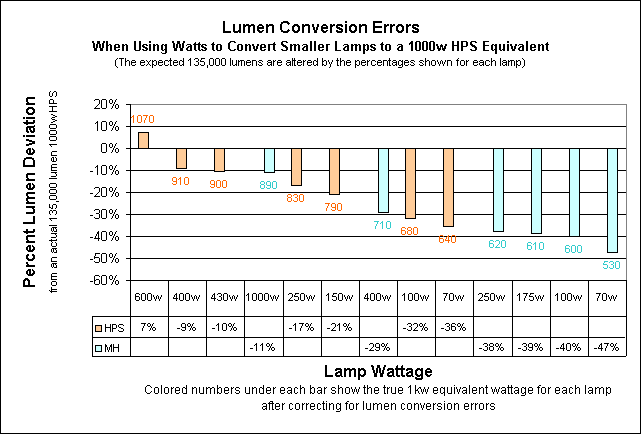Errors Introduced From Misrepresenting The Use Of Light
The precise degree to which light is misrepresented in watt-based ratings depends on the LPW rating for both of the lamps being compared. As these two 400w lamp examples from the previous page illustrate,
|
Crop Yield |
Space | Light total lumens (L) |
Energy watts (w) |
Space (g/sq ft) |
Light (g/kL) |
Energy (g/w) |
LPW |
| 1 | 284 |
10 |
49200 |
400 |
28.4 | 5.8 | 0.71 | 123 |
| 2 | 284 |
10 |
38400 |
400 |
28.4 | 7.4 | 0.71 | 96 |
the MH yield should have been rated 28% higher than the HPS (LPW's 123/96=128%), and the HPS yield should have been rated 22% lower than the MH (96/123=78%). However, being blind to light and to the LPW-gap between these two lamps, watt-based ratings essentially misrepresented light by underrating the MH lamp's yield by 28% and overrating the HPS by 22%, which in this particular case resulted in identical 0.71 g/w ratings. Given the 22 different HID lamps shown in the LPW table, there are literally hundreds of different lamp combinations just like this, each with different LPW-gaps and degrees to which they will misrepresent light.
The chart below shows combinations for 13 common HID lamps when each is being paired with a 1000w HPS lamp having 135,000 lumens. The % figures indicate the disconnect occurring in watt-based ratings, and by how much the error would underrate or overrate the yield in a g/w rating.
A 1000w HPS lamp was used in the chart because quite often grams/watt figures originating from smaller lamps are converted by some to appear as if they all originated from a common 1000w HPS lamp. The conversion, determined by the wattage of the lamps (1000w/100w=10), is then applied to the yield from the smaller lamp to make it appear as if it originated from a lamp with 10 times as much light. Ironically, this uninspired attempt to account for lamp differences by using an equivalent wattage still doesn't account for equivalent light, the same LPW-gap errors are still present. The resulting g/1kw rating is, unfortunately, another red herring. In the chart, the colored numbers under the bars indicate by how many watts this equivalent g/1kw rating misrepresents light. For example, using the same conversion, but with the lumens from a 100w HPS, its light would in fact be equivalent to that originating from a 680w HPS lamp (9,200*10=92,000), not from a 1kw HPS having 135,000 lumens. The 100w HPS garden's yield would still be underrated by -32% (92/135=68%) whether it's expressed as g/w or g/1kw.
An unfortunate consequence of using watts as a measure for light is that growers using smaller lamps, and who try to emulate g/w yields from other growers who use larger lamps, often fail to reach their g/w expectations by emulating what the other grower does, or how he uses light. This isn't because they're not working hard at improving their technique, but because the g/w figures they're trying to emulate often originate from a more efficient lamp, and not necessarily from a more efficient technique. A cross-lamp rating based on light, such as g/kL, would have pointed that out. Looking too hard at the g in g/w can make it easy to overlook the fact that the w, when misinterpreted to mean light, doesn't apply equally to gardens using different lamps.



